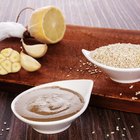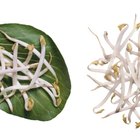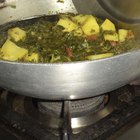
Although pesto is traditionally made with basil, garlic, Parmesan cheese, roasted pine nuts and olive oil, this Italian spread can contain nearly any fresh green, herb or nut, depending on the cook's taste and imagination. Pesto needs to be thick if you're planning to spread it on bread, set it out as a dip for vegetables or use it as a stuffing for chicken, but it's very easy to add too much olive oil and make it too thin. The easiest way to thicken up pesto is to refrigerate it for about an hour before serving, but if you're in a hurry, you have several other options to help save your pesto.
Step 1
Extra basil leaves or pine nuts can quickly thicken up pesto. Add the leaves or nuts to the mixture and pulse it in the food processor to blend. If you have to add significantly more basil leaves than your recipe originally called for, the flavor of your pesto may be affected, and you will need to add more Parmesan cheese, garlic and pine nuts to even it out. Add small amounts of each ingredient at a time and taste before adding more. Just don't add more olive oil, or you risk thinning out your newly thickened pesto.
Step 2
If you're out of fresh basil or you don't want to risk adding too much more basil flavor to your pesto, add a small bunch of torn spinach leaves to the thin pesto and pulse it in the food processor. The spinach will thicken the pesto without adding a distinctive flavor. If you don't mind adding a peppery flair to your pesto, add arugula leaves to the mixture.
Step 3
Toss a handful of breadcrumbs, croutons or torn bread pieces into the food processor and blend to thicken the pesto. Use unseasoned breadcrumbs or croutons, or you may alter the pesto's flavor with added seasonings.
Step 4
Add canned cannellini beans or chickpeas to your pesto to thicken it and add a burst of protein. Pour the beans into a strainer and rinse them with cool water, letting them drain completely before adding them to the food process. Add approximately 1/4 cup at a time, blend and check the pesto's consistency before adding more.
Related Articles

How to Crush Basil
Easy Tomato Basil Soup Recipe

How to Make Pico de Gallo

How Long Can You Refrigerate Nacho ...

How to Cook Pork Jowl Bacon in Collard ...

How to Blanch Kale for Freezing

How to Make Soup Out of Pulp From ...

How to Make Fresh Strawberry Frosting ...

How to Fix Too Much Italian Seasoning ...

How to Improve Jar Spaghetti Sauce With ...

How to Use a 40% Developer With Toner

Calories in Tahini Sauce

How to Soothe Irritation Bumps From ...

How to Cut Cabbage Very Finely

How to cook bean sprouts

How to Manage Thick, Coarse ...

Kasoori Methi Nutrition

Can You Substitute Spaghetti Sauce for ...

What Are the Health Benefits of Pico De ...

How to Add Irish Cream to Buttercream ...
References
- Farmer's Almanac: You Can Make Pesto Out of (Almost) Anything
- Serious Eats: How to Make Pesto
- Good Housekeeping Illustrated Cookbook; Elizabeth Wolf-Cohen
Tips
- Avoid making thin pesto by adding olive oil after you've blended the rest of the ingredients in the food processor. Add a little at a time, then pulse the mixture and check its consistency. Don't add the entire amount of olive oil called for in the recipe at one time.
- If you make your pesto too thick while attempting to thicken it up, blend in a little olive oil or water to thin it out slightly.
- If you're going to add the pesto to pasta, don't fret if it seems too thin. The starches in the cooked pasta will automatically thicken the pesto as you stir it in.
Writer Bio
Anika Torrance joined the "Mobile Press-Register" in 1997 as an advertising assistant and quickly moved into the newsroom, where she was a staff writer and copy editor for almost 10 years. She holds a Bachelor's degree with a double major in journalism and history from the University of Southern Mississippi, and completed a Master's degree in English at the University of Alabama in Huntsville.
Photo Credits
Jupiterimages/Stockbyte/Getty Images